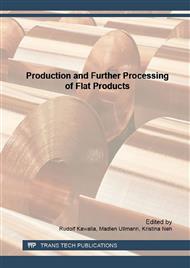p.158
p.163
p.167
p.174
p.183
p.193
p.200
p.207
p.215
Computer Model STAN 2000 and its Use in Practice of Steels Hot Rolling on Mill 2000 of Severstal
Abstract:
An integral computer model/program STAN 2000 for simulation of steels hot rolling on mill 2000 of SEVERSTAL was developed. The capacity of the model includes, for example, the following features:‒ control of power parameters and prediction of hot strip temperature for a given rolling and accelerated cooling regimes;‒ follow-up of the evolution of steel microstructure at all stages of strip production and prediction of ultimate mechanical properties (yield stress, ultimate tensile stress and relative elongation);‒ optimization of rolling regimes for existing steel grades and developing them for a new ones.The STAN 2000 program is written in С++ programming language and can work on all modern Microsoft Windows family operating systems. The program has a well-designed and user-friendly interface facilitating its practical use.The integral model was calibrated using an extensive data base on rolling regimes and forces, measured temperatures and final mechanical properties for a number of steel grades rolled on mill 2000 of SEVERSTAL with chemical compositions covering the following ranges of alloying elements content (mass.%): С(≤0.65); Mn(≤2.0); Si(≤1.0); Cr(≤0.9); Ni(≤0.6); Cu(≤0.5); Mo(≤0.4); Nb(≤0.05); V(≤0.065); Ti(≤0.06); B(≤0.003).Some results of calculations performed with STAN 2000 program for temperatures, rolling forces and mechanical properties are presented and compared with experimental data. Some examples of the program utilization in hot strip production on mill 2000 of SEVERSTAL are presented and discussed.
Info:
Periodical:
Pages:
183-189
Citation:
Online since:
May 2016
Keywords:
Permissions:
Share:
Citation:


